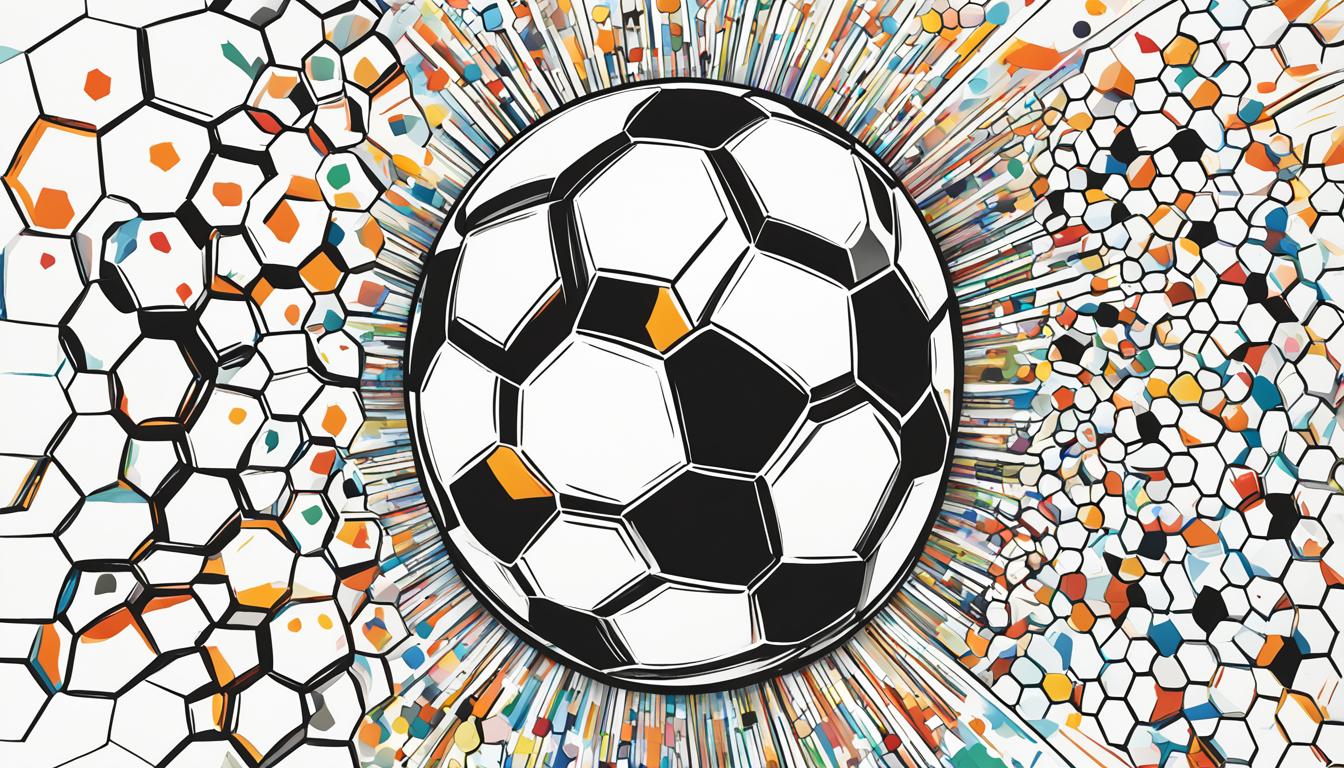How to Draw a Soccer Ball – Drawing Turorials and Coloring Tips
Have you ever wondered how to draw a soccer ball with its intricate pentagon shapes? Drawing a soccer ball can be a challenge, but fear not! In this article, we will guide you step-by-step on how to draw a soccer ball and provide coloring tips to make your artwork stand out. Get ready to showcase your artistic skills and create impressive soccer ball drawings.
- Learning how to draw a soccer ball requires understanding its complex structure of interconnected pentagons.
- Materials needed for drawing a soccer ball include drawing paper, pencils, black marker, and crayons.
- Follow our step-by-step guide to draw a soccer ball accurately, from sketching the main shape to adding shading and color.
- Add realism and texture to your soccer ball drawing by using techniques like cross-hatching and experimenting with colors.
- Enhance your soccer ball drawing with personalized touches like backgrounds, additional elements, and unique designs.
Understanding the Structure of a Soccer Ball
Before you dive into drawing a soccer ball, it’s essential to grasp its intricate structure. A soccer ball consists of multiple interconnected pentagon shapes that form a spherical pattern. Each pentagon has specific positioning and spacing, contributing to the overall appearance of the ball.
To help you recreate the unique design of a soccer ball with accuracy and precision, we’ve put together a step-by-step guide. By following our tutorial, you’ll be able to capture the essence and proportions of a soccer ball in your artwork.
Recreating the Intricate Pattern
Begin by drawing a circle as the foundation of your soccer ball. This circle will serve as a reference point for the pentagons. Make sure the circle is proportional to the size you want for your soccer ball drawing.
Next, add a tilted pentagon at the center of the circle. This pentagon will serve as a guide for the positioning of the other pentagons.
Extend lines from each point of the central pentagon, intersecting the circle. This will create the framework for the remaining pentagons.
Now, complete one pentagon by connecting the extended lines as shown in the guide.
Repeat this process to finish the rest of the pentagons, ensuring that they are evenly spaced and interconnected.
Finally, draw the final lines extending from each point to close off the pentagon shapes.
| Step | Description |
|---|---|
| 1 | Draw a circle as the main shape. |
| 2 | Add a tilted pentagon in the center of the circle. |
| 3 | Extend lines from each point of the pentagon. |
| 4 | Complete one pentagon as shown. |
| 5 | Repeat the same process to finish the rest of the pentagons. |
| 6 | Draw the final lines extending from each point. |
Following these steps will provide you with a solid foundation for drawing a soccer ball. Once you have mastered the structure, you’ll be ready to move on to the next steps of creating your artwork.
Materials Needed for Drawing a Soccer Ball
Before you start drawing a soccer ball, it’s important to gather the necessary materials. Having the right tools will make the process easier and more enjoyable. Here are the essential materials you’ll need:
- Drawing paper: A smooth surface is key for creating precise lines and details in your artwork. Choose a size that suits your preference.
- Pencils: Use pencils of different hardness (e.g., H, HB, B) to create light sketch lines and make adjustments as you go.
- Black marker: A black marker will help you outline the soccer ball with bold, defining lines. Opt for a marker with a fine tip for accuracy.
- Crayons: Crayons will be useful for adding color and shading to your soccer ball drawing. Select a variety of colors to bring your artwork to life.
Gathering these materials will ensure a smooth and hassle-free drawing process.
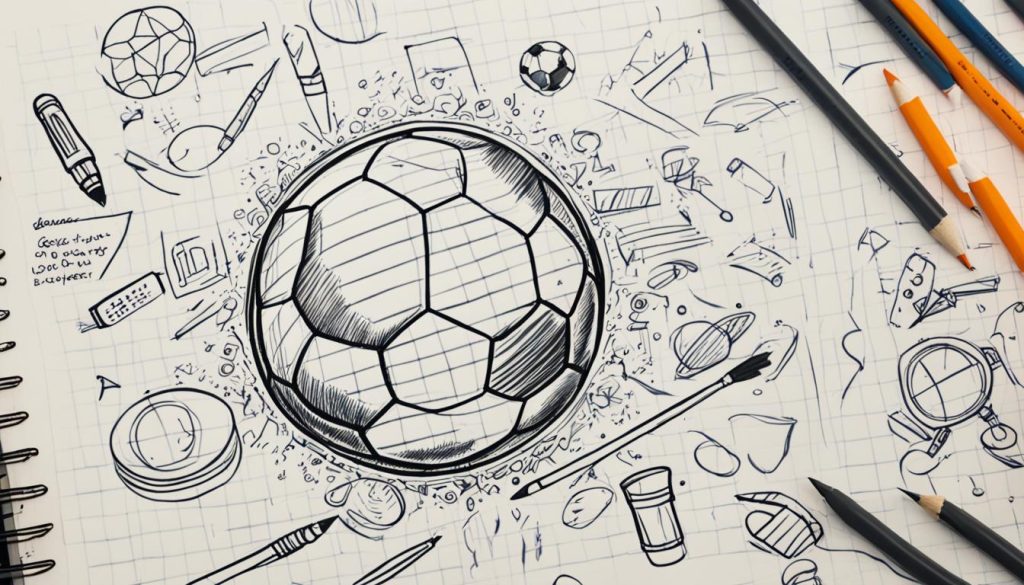
Recommended Brands for Drawing Materials:
| Drawing Paper | Pencils | Black Marker | Crayons |
|---|---|---|---|
| Strathmore | Derwent | Sharpie | Crayola |
| Winsor & Newton | Faber-Castell | Uni Posca | Prang |
| Canson | Staedtler | Sakura Pigma | Conté |
| Bee Paper | Prismacolor | Pilot Marker | Caran d’Ache |
These brands offer high-quality drawing materials that will enhance your soccer ball artwork. Feel free to explore other options based on your personal preferences.
Step-by-Step Guide to Drawing a Soccer Ball
Now it’s time to put pencil to paper and start drawing your soccer ball. Follow these step-by-step instructions:
- Draw a circle as the main shape.
- Add a tilted pentagon in the center of the circle.
- Extend lines from each point of the pentagon.
- Complete one pentagon as shown.
- Repeat the same process to finish the rest of the pentagons.
- Draw the final lines extending from each point.
- Trace the outline with a black marker and add gray crayon for shading.
- Color the rest of the soccer ball using crayons.
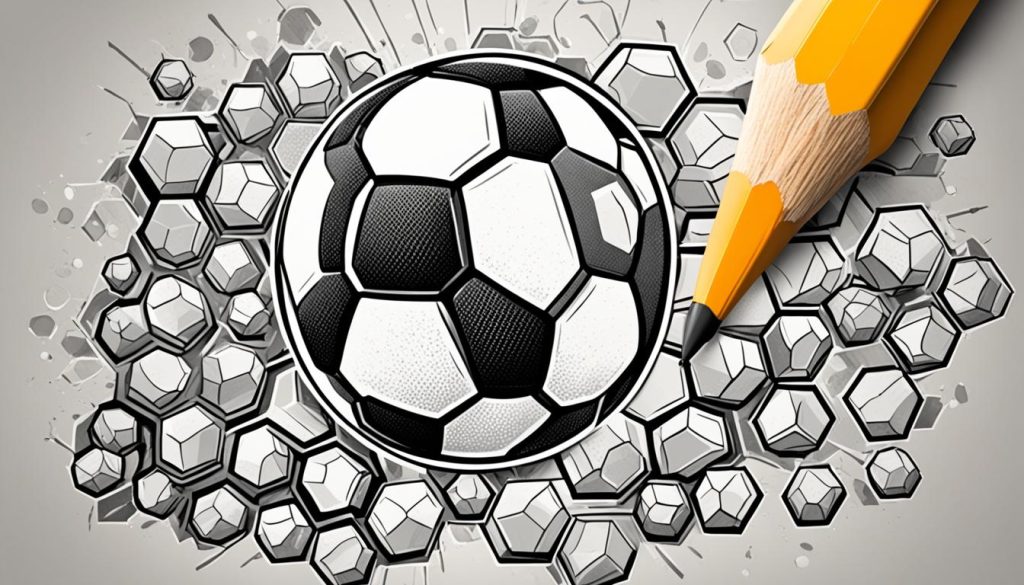
Follow these simple steps to create a realistic soccer ball drawing. The circle serves as the foundation for the ball, and the tilted pentagon creates the first pentagon shape. Extend lines from each point of the pentagon to create additional pentagons. Complete one pentagon and repeat the process to finish the rest of them. Draw the final lines extending from each point to form a cohesive pattern.
Once you have the outline, trace it with a black marker to make it bold and prominent. Add gray crayon for shading to create depth and dimension. Finally, bring your soccer ball to life by coloring the rest of it using crayons. Use vibrant colors to make your soccer ball drawing pop.
With this step-by-step guide, you’ll be able to create a stunning soccer ball drawing that showcases your artistic skills. Let your creativity flow and have fun throughout the drawing process!
Adding Realism and Texture to Your Soccer Ball Drawing
To make your soccer ball drawing look more realistic, you can add texture and shading.
First, use the cross-hatching technique to create texture lines on the pentagons of your soccer ball. This technique involves drawing a series of parallel lines in one direction and then crossing them with lines in the opposite direction. The resulting intersecting lines give the illusion of texture and depth.
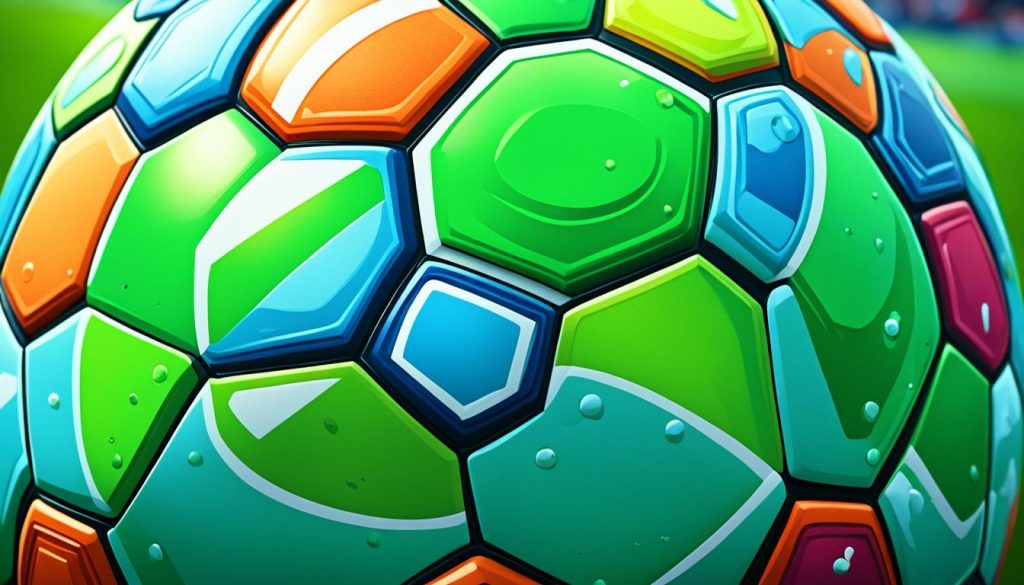
Experiment with different colors to make your soccer ball drawing more vibrant and visually appealing. Instead of just using black and white, consider using shades of gray or even introducing subtle pops of color. Be bold and creative with your color choices!
Next, focus on adding highlights and shadows to your drawing. This will enhance the three-dimensional effect of the soccer ball and make it appear more lifelike. Use lighter shades to create highlights on the curved surfaces of the ball where the light would naturally hit, and darker shades to indicate shadows in the creases and recesses.
Here’s an example of how highlights and shadows can dramatically improve the realism of your soccer ball drawing:
“Adding texture, vibrant colors, and realistic highlights and shadows can elevate your soccer ball drawing from a simple illustration to a visually captivating artwork.”
– Renowned artist, Jane Thompson
By following these tips and techniques, you can take your soccer ball drawing to the next level and create a stunning piece of art that truly captures the essence of this beloved sport.
Coloring Tips for Your Soccer Ball Drawing
When it comes to coloring your soccer ball drawing, following expert tips can make your artwork stand out. With a few simple techniques, you can bring your soccer ball to life and make it visually appealing. Here are some detailed soccer ball drawing tips and tricks to enhance your coloring process:
1. Apply a Base Coat of Light Gray
Start by applying a base coat of light gray to create a solid foundation for your soccer ball. This will help you establish the overall shape and structure before adding more intricate details.
2. Fill the Dark Pentagons with Black
The dark pentagons on a soccer ball are visually distinct and add depth to the overall design. Fill these pentagons with black color to create a striking contrast against the lighter background.
3. Add Shading and Contouring
To give your soccer ball drawing more depth and dimension, add shading and contouring. Use darker shades of gray or black to create shadows and emphasize the curvature of the ball. This will make your artwork appear more realistic.
4. Personalize with Details
To add a personal touch to your soccer ball drawing, consider adding details like stitching or background elements. You can use white or light colors to draw realistic stitching lines, or get creative and experiment with different patterns and designs.
By following these expert tips for drawing a soccer ball, you can take your artwork to the next level. Remember to have fun and let your creativity shine as you bring your soccer ball to life with vibrant colors and attention to detail.
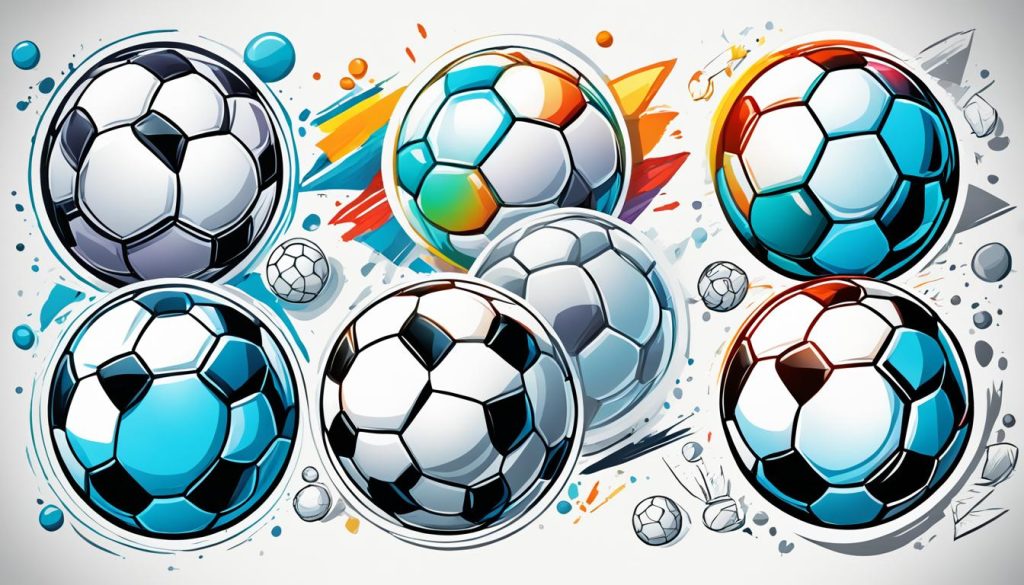
Taking Your Soccer Ball Drawing to the Next Level
If you want to take your soccer ball drawing to the next level, there are a few additional techniques you can try. Adding extra elements to your artwork will add interest and uniqueness. Here are some expert tips and tricks:
- Add a Background: Create a more dynamic composition by adding a background to your soccer ball drawing. Consider drawing a soccer field or a crowded stadium to showcase the environment in which the sport is played.
- Incorporate Human Characters and Sports Equipment: Show your love for the game by including human characters like players or fans in your drawing. You can also add other sports equipment such as soccer cleats or a goal post to enhance the soccer theme.
These extra elements will not only make your drawing visually engaging, but also reflect your creativity and passion for soccer.
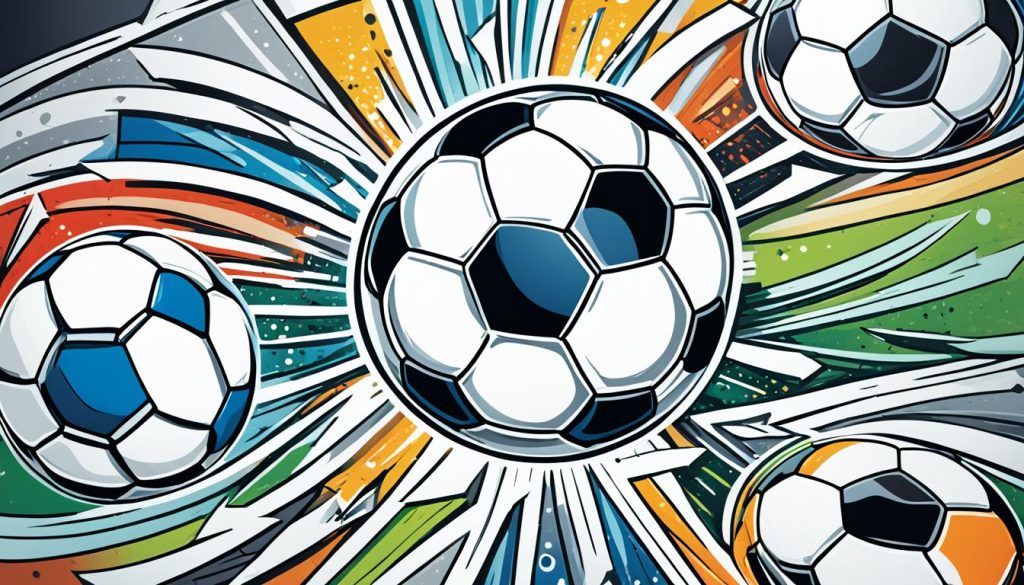
Tip:
When incorporating human characters or other sports equipment, pay attention to proportion and perspective. These elements should be scaled appropriately to create a realistic and visually appealing composition.
Inspiration for Your Soccer Ball Drawing
Looking for some inspiration to kickstart your soccer ball drawing? Feast your eyes on this adorable soccer ball drawing created by our talented artist:

This cute soccer ball drawing features a stylized design with a delightful smile, adding charm and personality to the artwork. It’s a perfect example of how you can infuse creativity into your own soccer ball drawings.
Use this drawing as a reference to create your own unique soccer ball design. You can incorporate different colors, patterns, or even other elements that showcase your personal style. Let your creativity shine and put your own spin on the artwork.
Tips for Creating Realistic Soccer Ball Art
Creating realistic soccer ball art requires attention to detail and an understanding of the ball’s structure. To bring your artwork to life, you should focus on accurate proportions, shading, and texture. Here are some expert tips and tricks to help you achieve impressive soccer ball drawings:
- Study reference images: Use reference images of soccer balls to observe the patterns and shadows. This will help you understand how light interacts with the surface of the ball and create more realistic renderings.
- Pay attention to proportions: Ensure that the pentagons and overall shape of the soccer ball are proportionate and correctly aligned. This will contribute to the ball’s realistic appearance.
- Master shading techniques: Experiment with different shading techniques, such as cross-hatching or stippling, to add depth and dimension to your soccer ball drawing. Pay close attention to the areas of light and shadow.
- Create texture: Use fine lines or dots to depict the texture of the ball’s pentagons. This will give your drawing a more tactile feel and enhance its realism.
- Practice regularly: Like any skill, drawing soccer balls requires practice. Set aside dedicated time to hone your skills, experiment with different techniques, and refine your drawing style.
“The details are not the details. They make the design.” – Charles Eames
Sample Table: Demonstrating Shading Techniques
| Shading Technique | Description |
|---|---|
| Cross-Hatching | Using intersecting lines to create shading and texture. |
| Stippling | Using small dots to create shading and texture. |
| Smudging | Blending pencil or charcoal to create smooth shading transitions. |
| Hatching | Using parallel lines to create shading and texture. |

By following these expert tips and practicing consistently, you’ll be able to create realistic and impressive soccer ball art. So grab your drawing tools and let your creativity shine on the canvas!
Celebrating Your Soccer Ball Drawing
Congratulations! You have successfully learned how to draw a soccer ball with our step-by-step guide. Now it’s time to celebrate your achievement and have fun with your artwork. Remember to embrace your unique style and let your creativity shine. Whether you prefer realistic or stylized soccer ball drawings, the most important thing is to enjoy the process and express yourself through your art.
To further develop your artistic skills, keep practicing and exploring new techniques. Here are some expert tips for drawing a soccer ball:
- Pay attention to the accuracy of the proportions and shapes to capture the essence of a soccer ball.
- Experiment with shading and highlighting to give your drawing depth and dimension.
- Consider adding additional elements such as a soccer field or player to create a more dynamic composition.
- Don’t be afraid to add your own personal touch and unique style to your artwork.
Remember, drawing is a journey of continuous learning and improvement. So keep pushing your boundaries and challenging yourself. Your soccer ball art will become more impressive with time and practice.
Inspiration for Your Next Soccer Ball Drawing
Are you looking for inspiration for your next soccer ball drawing? Check out this amazing artwork created by Artist’s Name. The attention to detail and vibrant colors make this drawing truly captivating.
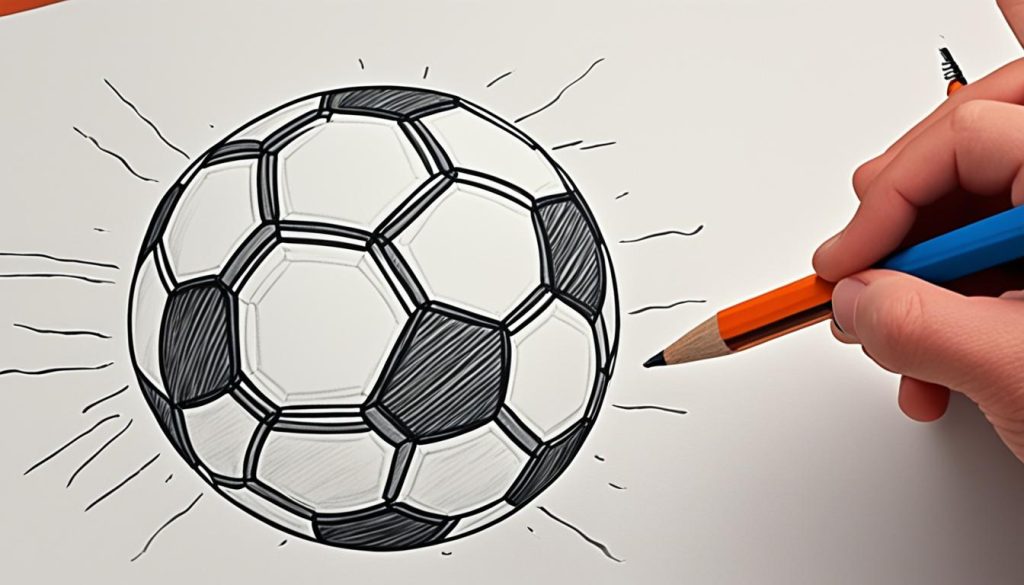
Use this drawing as a reference or starting point for your own unique designs. Let your imagination soar and create soccer ball art that showcases your individuality and creativity.
Expert Tips for Drawing a Soccer Ball
| Tips | Description |
|---|---|
| Study reference images | Examine real soccer balls to understand the patterns, shadows, and textures. |
| Practice regularly | Repetition is key to improving your drawing skills. Set aside dedicated time for drawing. |
| Experiment with techniques | Try different shading techniques, color combinations, and drawing styles to find what works best for you. |
| Seek feedback | Share your artwork with others and ask for constructive criticism to identify areas for improvement. |
With these expert tips and your enthusiasm, you’ll continue to enhance your soccer ball drawing abilities and create stunning pieces of art. Keep up the great work!
Conclusion
Drawing a soccer ball may initially seem challenging, but with the right guidance and practice, anyone can achieve impressive results. This article has provided a comprehensive guide on how to draw a soccer ball, covering everything from understanding its structure to adding realism and texture. By following the step-by-step instructions and incorporating your own artistic flair, you’ll be able to create stunning soccer ball artwork that truly stands out.
Remember, the key to mastering the art of drawing a soccer ball lies in understanding its unique pentagon structure. By carefully placing and connecting these shapes, you can recreate the intricate pattern that defines a soccer ball. Adding texture and shading techniques will further enhance the realism, making your drawing come to life.
Don’t be afraid to experiment with colors and personal touches to make your soccer ball art truly unique. Whether you choose a realistic approach or opt for a more stylized design, the possibilities are endless. So grab your drawing materials, follow the steps outlined in this article, and start perfecting your soccer ball drawing skills today. Get ready to amaze yourself and others with your newfound artistic talent!
